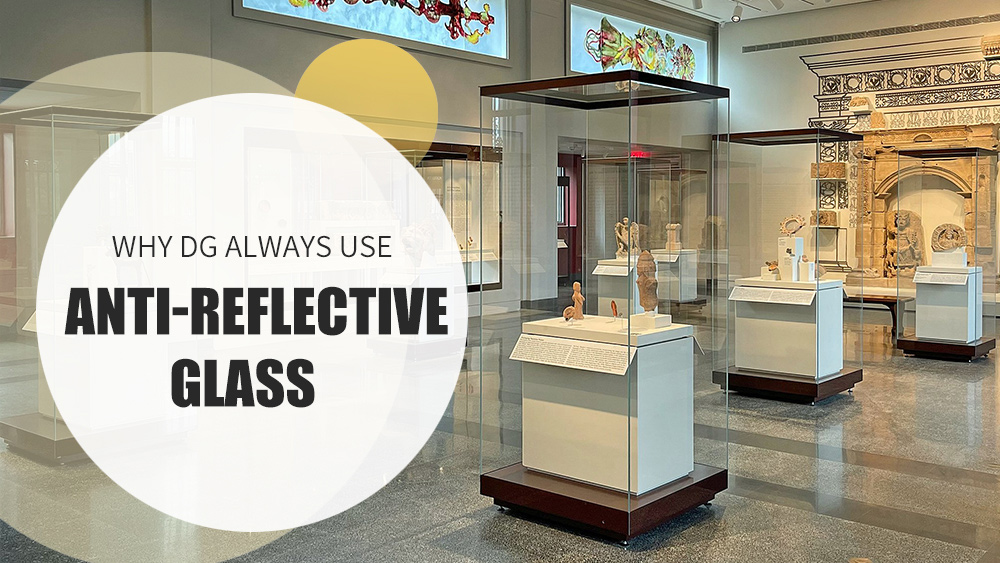当前位置:Home » DG News Center » Up-to-date News » Reasons for Anti-reflective glass Dominating the Museum Display Case Market
Reasons for Anti-reflective glass Dominating the Museum Display Case Market
As museums continue to develop, the requirements for exhibit protection and display have become increasingly higher. Display cases, as an essential tool for showcasing exhibits, have a critical role to play, and the choice of materials is of utmost importance. Among the many materials available, Anti-reflective glass has gained popularity due to its excellent transparency and display effects. This article will discuss the reasons behind Anti-reflective glass dominating the museum display case market from the perspectives of its introduction, advantages, and reasons for museums choosing Anti-reflective glass.
Anti-reflective glass is a high-transparency glass treated with a special process that lowers its reflectivity by applying a multilayer coating to the glass surface, thereby enhancing its transparency. The manufacturing principle involves coating the glass surface with a nanometer-thick inorganic oxide film, which refracts and scatters the reflected light on the glass surface, reducing reflectivity, increasing transmittance, and achieving an anti-reflective effect.
Compared to ordinary glass, Anti-reflective glass has several apparent advantages:
Higher transparency and more accurate color reproduction. Ordinary glass has a strong surface reflection, causing interference, while Anti-reflective glass reduces reflected light and increases transmittance by applying an inorganic oxide film, making the color of exhibits more realistic and natural.
Better protection for exhibits. Ordinary glass has strong reflected light, causing high light exposure to the exhibits. Anti-reflective glass effectively reduces light damage to the exhibits, offering better protection.
Enhanced visual effects. Anti-reflective glass reduces reflected light, allowing viewers to better appreciate exhibits and improving visual and display effects.
Although Anti-reflective glass is relatively expensive, the museum display case industry considers it a worthwhile investment. In fact, the trend of using Anti-reflective glass in museum display cases has become increasingly common, especially in high-end museums and exhibition halls. Using Anti-reflective glass can improve the display of exhibits and allow visitors to appreciate them more comfortably. Additionally, Anti-reflective glass provides better protection for museum exhibitions.

Firstly, using Anti-reflective glass significantly reduces glare and reflections, improving the display of exhibits. Compared to ordinary glass, Anti-reflective glass has a light reflection rate of less than 1%, significantly reducing light reflection and making exhibit details clearer. Viewers can better appreciate the details and quality of exhibits, enhancing their viewing experience. Moreover, Anti-reflective glass reduces glare, protecting the viewers' vision and allowing them to comfortably view exhibits.
Secondly, Anti-reflective glass provides better protection for museum exhibitions. Museum exhibits are usually precious and require special protective measures. Anti-reflective glass blocks over 99% of ultraviolet radiation, reducing UV damage and protecting exhibits from UV-related harm. Simultaneously, Anti-reflective glass reduces indoor dust accumulation, minimizing contamination and damage to exhibits. These protective measures ensure the exhibits remain intact and prolong their lifespan.
Lastly, using Anti-reflective glass also offers commercial advantages for the museum display case industry. As the number and scale of museums and exhibition halls increase, display case manufacturers face heightened market competition. By using Anti-reflective glass, museum display cases can provide better display effects and protection measures, offering clients higher-quality display case products and gaining a more advantageous position in market competition.





 (+86)13610079233
(+86)13610079233 info@dgfurniture.com
info@dgfurniture.com
 24/7 Mobile/Whatsapp/Wechat:+86 13610079233
24/7 Mobile/Whatsapp/Wechat:+86 13610079233 Email:info@dgfurniture.com
Email:info@dgfurniture.com China Marketing Center: 14th Floor, Zhihui International Building, Taiping Town, Guangzhou(Full Floor)
China Marketing Center: 14th Floor, Zhihui International Building, Taiping Town, Guangzhou(Full Floor)